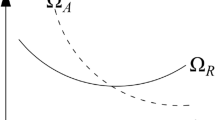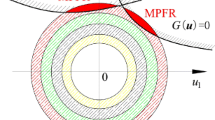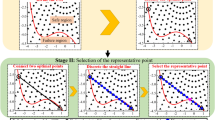Abstract
In practical engineering problems, accurate reliability assessment often is computationally expensive with time-consuming numerical models or simulation models. How to obtain an accurate reliability index with a fewer number of calls to original performance function in reliability analysis has become an important challenge. For the purpose of reducing the computational cost in reliability analysis, this work develops an adaptive failure boundary approximation method (AFBAM) by combining Kriging and uniform sampling with a new adaptive learning strategy. The proposed AFBAM makes full use of the binary classification feature of reliability analysis in the way that the failure boundary of the original model can be efficiently approximated. The number of experimental design samples is constantly updated by selecting informative samples with the proposed learning strategy. In order to ensure classification accuracy of the constructed Kriging model, a new stopping criterion is designed based on average misclassification probability and misclassification ratio. The proposed AFBAM technically makes reliability evaluation phase independent of adaptive iterative process, which greatly improves the efficiency of model refinement phase. At last, five examples involving nonlinearity problem, small failure probability problem and practical engineering problem are tested to verify the efficiency of the proposed AFBAM.













Similar content being viewed by others
References
Lemaire M (2010) Structural reliability. Wiley, London
Zeng P, Li TB, Jimenez R, Feng XD, Chen Yu (2018) Extension of quasi-Newton approximation-based SORM for series system reliability analysis of geotechnical problems. Eng Comput 34:215–224
Choi SK, Grandhi RV, Canfield RA (2007) Reliability-based structural design. Springer, London
Ibrahim Y (1991) Observations on applications of importance sampling in structural reliability analysis. Struct Saf 9(4):269–281
Au SK, Beck JL (2002) Important sampling in high dimensions. Struct Saf 25(2):139–163
Angelis MD, Patelli E, Beer M (2015) Advanced line sampling for efficient robust reliability analysis. Struct Saf 52:170–182
Pradlwarter HJ, Schuëller GI, Koutsourelakis PS, Charmpis DC (2007) Application of line sampling simulation method to reliability benchmark problems. Struct Saf 29(3):208–221
Au SK, Beck JL (2001) Estimation of small failure probabilities in high dimensions by subset simulation. Probab Eng Mech 16(4):263–277
Au SK (2005) Reliability-based design sensitivity by efficient simulation. Comput Struct 83(14):1048–1061
Yang IT, Hsieh Y-H (2013) Reliability-based design optimization with cooperation between support vector machine and particle swarm optimization. Eng Comput 29:151–163
Basudhar A, Missoumy S (2010) Reliability assessment using probabilistic support vector machines (PSVMs). In: 51st AIAA/ASME/ASCE/AHS/ASC structures, structural dynamics, and materials conference, 12–15
Pan Rongjiang, Skala Vaclav (2011) A two-level approach to implicit surface modeling with compactly supported radial basis functions. Eng Comput 27:299–307
Li X, Gao WK, Gu LX, Gong CL, Jing Z, Su H (2017) A cooperative radial basis function method for variable-fidelity surrogate modeling. Struct Multidisc Optim 56:1077–1092
Papadopoulos V, Giovanis DG, Lagaros ND, Papadrakakis M (2012) Accelerated subset simulation with neural networks for reliability analysis. Comput Methods Appl Mech Eng 223:70–80
Amiri M, Amnieh HB, Hasanipanah M, Khanli LM (2016) A new combination of artificial neural network and K-nearest neighbors models to predict blast-induced ground vibration and air-overpressure. Eng Comput 32:631–644
Simpson TW, Peplinski JD, Koch PN, Allen JK (2001) Metamodels for computer-based engineering design: survey and recommendations. Eng Comput 17:129–150
Kleijnen JPC (2009) Kriging metamodeling in simulation: a review. Eur J Oper Res 192(3):707–716
Queipo Néstor V, Arévalo Carlos J, Pintos Salvador (2005) The integration of design of experiments, surrogate modeling and optimization for thermoscience research. Eng Comput 20:309–315
Yondo R, Andres E, Valero E (2018) A review on design of experiments and surrogate models in aircraft real-time and many-query aerodynamic analyses. Prog Aerosp Sci 96:23–61
Xiong F, Xiong Y, Chen W, Yang S (2009) Optimizing Latin hypercube design for sequential sampling of computer experiments. Eng Optimn 41(8):793–810
Qian Peter Z G (2012) Sliced latin hypercube designs. J Am Stat Assoc 107(497):393–399
Viana FAC, Gerhard V, Vladimir B (2010) An algorithm for fast optimal Latin hypercube design of experiments. Int J Numer Methods Eng 82:135–156
Sheikholeslami R, Razavi S (2017) Progressive latin hypercube sampling: an efficient approach for robust sampling-based analysis of environmental models. Environ Model Softw 93:109–126
Bichon BJ, Eldred MS, Swiler LP, Mahadevan S, McFarland JM (2008) Efficient global reliability analysis for nonlinear implicit performance functions. AIAA J 46:2459–2468
Echard B, Gayton N, Lemaire M (2011) AK-MCS: an active learning reliability method combining Kriging and Monte Carlo simulation. Struct Saf 33(2):145–154
Echard B, Gayton N, Lemaire M (2013) A combined Importance Sampling and Kriging reliability method for small failure probabilities with time-demanding numerical models. Reliab Eng Syst Saf 111:232–240
Huang X, Chen J, Zhu H (2016) Assessing small failure probabilities by AK–SS: an active learning method combining Kriging and Subset simulation. Struct Saf 59:86–95
Zheng P, Wang CM, Zong Z, Wang L (2017) A new active learning method based on the learning function U of the AK-MCS reliability analysis method. Eng Struct 148:185–194
Lv ZY, Lu ZZ, Wang P (2015) A new learning function for Kriging and its applications to solve reliability problems in engineering. Comput Math Appl 70:1182–1197
Basudhar A, Missoum S (2008) Adaptive explicit decision functions for probabilistic design and optimization using support vector machines. Comput Struct 86:1904–1917
Pan Q, Dias D (2017) An efficient reliability method combining adaptive support vector machine and Monte Carlo simulation. Struct Saf 67:85–95
Song KL, Zhang YG, Yu XS, Song BF (2019) A new sequential surrogate method for reliability analysis and its applications in engineering. IEEE Access 7:60555–60571
Gaspar B, Teixeira AP, Guedes SC (2017) Adaptive surrogate model with active refinement combining Kriging and a trust region method. Reliab Eng SystSaf 165:277–291
Sun Z, Wang J, Li R, Tong C (2017) LIF: a new Kriging based learning function and its application to structural reliability analysis. Reliab Eng Syst Saf 157:152–165
Lophaven SN, Nielsen HB, Sondergaard J (2002) DACE, a matlab Kriging toolbox, version 2.0. Tech. Rep. IMM-TR-2002-12; Technical University of Denmark; 2002a
Lebrun Régis, Dutfoy Anne (2009) Do Rosenblatt and Nataf isoprobabilistic transformation really differ? Probab Eng Mech 24(4):577–584
Kocis L, Whiten WJ (1997) Computational investigations of low-discrepancy sequences. ACM Trans Math Softw 23(2):266–294
Acknowledgements
This study was supported by the National Natural Science Foundation of China [Grant No. 51675428] and the Fundamental Research Funds for the Central Universities [Grant No. 3102015 BJ (II) JL01].
Author information
Authors and Affiliations
Corresponding author
Additional information
Publisher's Note
Springer Nature remains neutral with regard to jurisdictional claims in published maps and institutional affiliations.
Rights and permissions
About this article
Cite this article
Song, K., Zhang, Y., Zhuang, X. et al. An adaptive failure boundary approximation method for reliability analysis and its applications. Engineering with Computers 37, 2457–2472 (2021). https://doi.org/10.1007/s00366-020-01011-0
Received:
Accepted:
Published:
Issue Date:
DOI: https://doi.org/10.1007/s00366-020-01011-0




